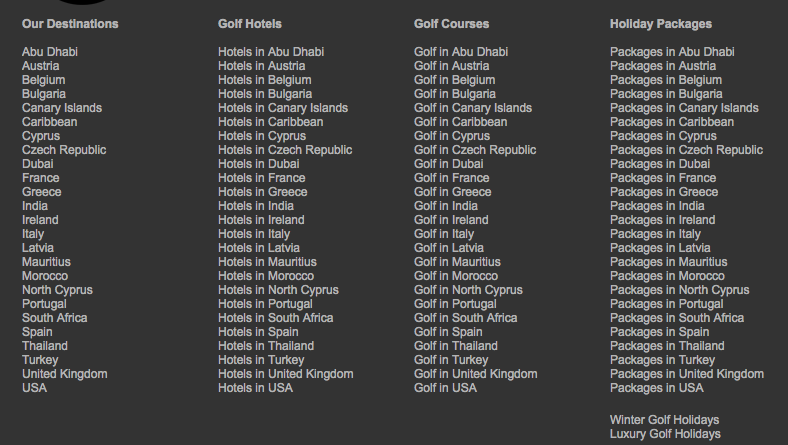As SEO professionals, we talk a lot about how to produce the best websites, the best content, and provide the best value. While these are all important things to know, it’s also important for us to be able to recognize the negative signs that Google is looking for.
With Google quality updates seemingly occurring on a monthly basis and since the Fred event of March 2017, website quality issues have begun to take center stage.
Section 7 of Google’s Search Quality Guidelines advises the rating team on how to identify the lowest quality pages on the Internet and heavily reinforces the underlying goal that the websites and content that Google serves is created to be helpful for users.
Excessive & Unnatural Internal Structural Links
Google has however been talking about its low-quality criteria list since as early as 2012 when they filed a patent that directly targets websites repeating internal links across sidebars and footers.
This was once an SEO technique (as demonstrated by the below image) but soon became an unnatural form of SERP manipulation.
 Internal footer link spam; lots of unnatural and repetitive anchor text to “money pages”.
Internal footer link spam; lots of unnatural and repetitive anchor text to “money pages”.While there are some more obvious signs that a website is untrustworthy, like it’s been hacked or it’s full of spam comments and spam pages, there are some less obvious factors that Google considers to be low-quality signals.
Phantom 2
An interesting note from the patent is that it was initially filed in June 2012, but was only published in its current form during April 2015.
Toward the end of April 2015, we began to see a change in Google’s algorithm that in May 2015 was dubbed the Phantom 2 update. While it is speculation that Phantom 2 took into account the newly patented low-quality criteria list, a lot of websites with poor quality content saw upwards of a 10 percent decrease in organic search traffic.
Over-Monetization of Content
Google considers a webpage to be deceptive in nature if it is designed to trick users, search engines, or both. If it is deemed that this is the case, Google commands that these pages are recorded as being the lowest quality.
One of the main takeaways from the Fred update (and subsequent quality updates to the algorithm) is the impact on search performance for webpages containing excessive monetized affiliate links and ads.
In the past year, Google has, in my opinion, taken greater steps to cater for high volume search queries that don’t have a single dominant interpretation.
For a number of queries, Page 1 of Google has become less about being position 1 to 10, but more a compilation of results that best match a number of common search intents.
Ads & Affiliate Links
Websites disguising adverts as the main website content (e.g., adverts interwoven into the main content or time delay splash ad screens) are examples of these.
In December 2016, one of Google’s search quality analysts, Nathan Johns, posted via Twitter that news websites including affiliate links (such as Taboola and Outbrain) should think twice about doing so.
 The effect of a quality update impacting a website with heavy sponsored content elements on the page.
The effect of a quality update impacting a website with heavy sponsored content elements on the page.However, not all websites have taken notice of this warning. I’ve seen news and content aggregator websites this year seeking penalty removal services when their issue is, in fact, the number of ads and affiliate content blocks built into their templates.
Google wants the main focus of the page to be its main content – users shouldn’t have to scroll past affiliate links and ads or interact with intrusive overlays.
Another issue with affiliate links, such as Taboola and Outbrain, is that they blend in with the page (on most occasions). This makes them seem like they belong on the page and this gives them an element of trust that empowers users to click on them (which is the point), but this is bad in Google’s eyes and affects your quality rating.
E-commerce Trust Factors
Another issue I’m increasingly coming across is the lack of attention to detail (or just lack of) e-commerce hygiene pages and hygiene content.
In the search quality guidelines, Google outlines the Your Money or Your Life principle (as outlined by Julia McCoy here) and scrutinizes the quality and authenticity of this content.
Financial Transaction Pages
These are sometimes mistaken as just being the cart/checkout and subsequent stages on the website, but any page that allows a user to “purchase” or add a product to their cart/basket also falls under this category.
These pages need to contain prominent links to standard e-commerce hygiene pages (e.g., refund and returns policies, delivery information, and terms and conditions).
It’s also worth highlighting that I come across a lot of these pages that are duplicates from other websites or automatically generated through online software tools. These are important user pages and shouldn’t be executed with the least effort possible.
Financial Information Pages
If you have content on your website that provides the user with any form of advice or guidance relating to their finances, financing product purchases on your own site, or to do with insuring products or services – the content and information provided needs to be of the highest quality.
It’s important to understand the relationship between keywords and content. The days of individual pages being made to rank for individual keywords – leading to a lot of thin, low-quality pages – are over.
Looking at an example from the travel insurance sector, someone has decided to create a page for North American Travel Insurance and then individual pages for the USA, Canada, Cuba, and Mexico.
None of these pages actually offer any actual value for a user when looking for insurance (for these specific countries) as all link toward an inquiry form or generic product pages. Aside from the fact these are YMYL pages, this practice of creating low-quality content damages the domain ecosystem as a whole and reduces its value proposition.
Conclusion
A lot can be said for getting the SEO basics right. A big part of this is making sure that your hygiene pages and internal linking structures cater for users, and not passing link equity to the money pages, especially for e-commerce and brochure service websites.
Image Credits
In-Post Photos: Screenshots by Dan Taylor. Taken September 2017.





